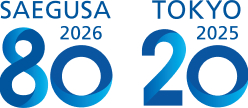Recent Trend of Japanese Trademark Prosecution
2023.08
At the end of July 2023, the Japan Paten Office (JPO) released their annual report on statistics of IP procedures before them in 2022 with an aim to promote public awareness and understanding of the IP system in Japan. Some of the statistics regarding trademark are as below.
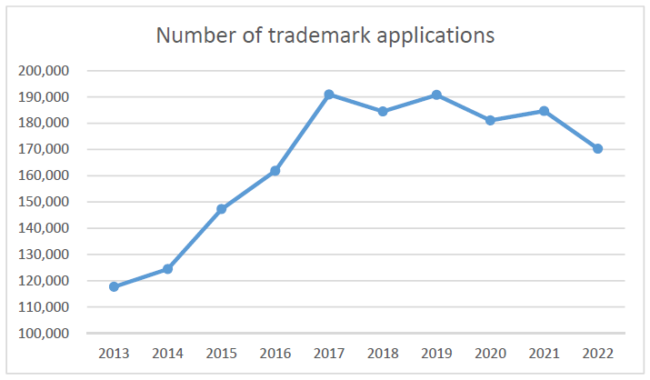 -2022 : 170,275, of which 19,769 were based on international registrations
-2022 : 170,275, of which 19,769 were based on international registrations
-2021 : 184,631, of which 20,094 were based on international registrations
-2020 : 181,072, of which 17,924 were based on international registrations
-2019 : 190,773, of which 19,450 were based on international registrations
-2018 : 184,483, of which 17,802 were based on international registrations
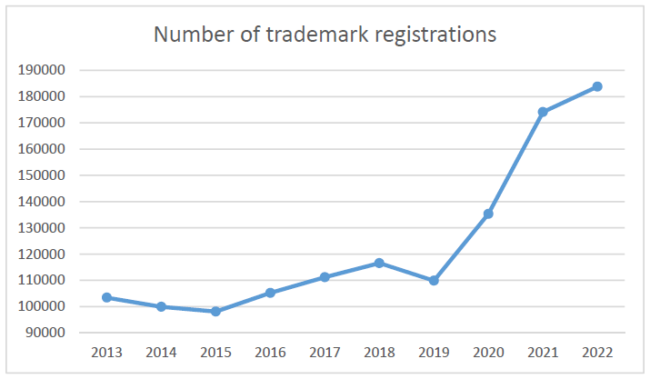 -2022 : 183,804
-2022 : 183,804
-2021 : 174,098
-2020 : 135,313
-2019 : 109,859
-2018 : 116,547
Compared to the previous year’s figures, although the number of trademark applications decreased, the number of trademark registrations increased by 5.6 % and it is the highest number in the last ten years. The decrease in the number of trademark applications based on international registrations was about 1.6 % year-on-year, whereas one of trademark applications filed with the JPO directly was about 8.5% year-on-year. In our view, the highest record of number of trademark registrations in 2022 came partly from large amounts of trademark applications of the previous year, and that an increase in official fees for trademark registration in April 2022 might affect the number of trademark applications filed last year.
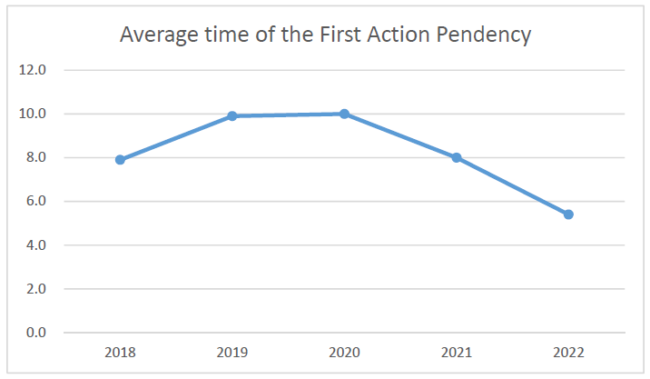 -2022 : 5.4 months
-2022 : 5.4 months
-2021 : 8.0 months
-2020 :10.0 months
-2019 : 9.9 months
-2018 : 7.9 months
The First Action pendency (FA pendency) is the period from filing an application to receiving a first examination outcome, i.e. a first Office Action or a notice of allowance, from the JPO, and its average time was drastically shortened last year. According to the JPO, although the basis of calculation of the above average time includes the FA pendency for expedited applications, expedited applications made up less than 5% of trademark applications filed last year, and hence we believe that counting the FA pendency for expedited applications did not have much influence on the calculation of the above average time. In the meantime, the Minister of Economy, Trade and Industry set the JPO’s goals regarding their examination period last year, and one of them was to issue the first examination outcome for a non- expedited application within 6 to 8 months from the filing date. This year, the Minister of Economy, Trade and Industry set a higher goal for the JPO and the JPO is expected to issue it within 5.5 to 7.5 months from the filing date. Therefore, given the JPO’s higher goal of this year and the decrease in the number of trademark applications filed last year, we anticipate that the average time would become shorter this year, or, at least, the average time of this year would be at the same level as the last year. We believe that such fast examination brings about benefit for trademark owners because they can register their marks sooner than ever before and they can use their mark safely after the registration. In this regard, if trademark owners wish to register their marks as soon as possible, it is one option for them to expedite their trademark applications by using the accelerated examination system. Although trademark applications based on international registrations, and ones for non-traditional trademarks, which are motion marks, hologram marks, marks consisting solely of colors, sound marks, position marks and some three-dimensional marks, are not subject to the accelerated examination, an applicant can expect to receive the first examination outcome within three months after filing a request for the accelerated examination if the request is accepted by the JPO. According to the JPO, applicants allegedly received the first examination outcome after 1.9 months from filing a request for the accelerated examination on average last year in case of their requests being accepted.
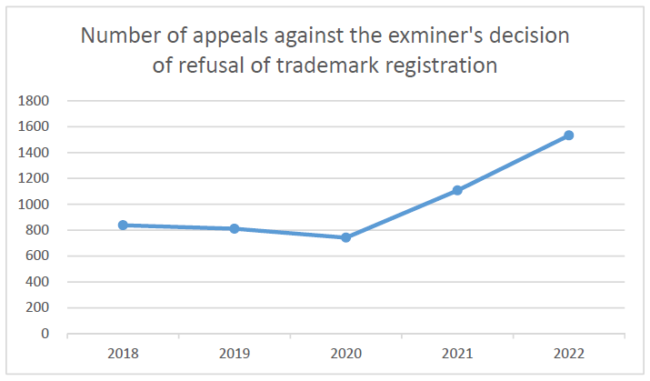 -2022 : 1,532
-2022 : 1,532
-2021 : 1,107
-2020 : 742
-2019 : 811
-2018 : 838
Compared to the previous year’s figures, the number of appeals against the Examiner’s decision of refusal of trademark registration increased rapidly. It seems that this surge stemmed from the previous year’s high success rate of the appeal against the Examiner’s decision of refusal among the cases in which a final decision was made, which was 81.7% according the statistics released by the JPO. From the JPO’s annual report of this year, it can be calculated that the last year’s success rate of the same was 67.2%, and it is still a good level even though it dropped from the previous year. Therefore, given that a certain number of the examiner’s decisions of refusal of trademark registration can still be expected to be overturned at the appeal, we anticipate that many applicants would try to file an appeal against the examiner’s decision of refusal this year as well. In our view of the success rate, it seems that a flexible decision can be expected to be rendered by the JPO’s Appeal Board comprising three board examiners at the appeal, whereas a conservative decision tends to be rendered by an examiner at the first examination. It may be difficult for examiners to render a flexible decision at the first examination since they need to check the registrability of the applied mark solely in principle. However, given the applicant’s burden of filing an appeal against an examiner’s unfavorable decision, we hope that examiners make more flexible decision at the first examination. In the meantime, according to the JPO, there was no case in which the IP High Court overturned the appeal decision of the JPO’s Appeal Board refusing registration of the applied mark in 2022. Therefore, we believe that there is not much difference between the decisions of the JPO’s Appeal Board and the IP High Court.
